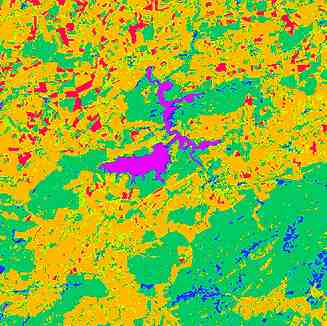Image processing
Unsupervised classification
…or ‘anything goes’
In unsupervised classification, the computer is allowed to analyse all of the spectral signatures of all of the image’s pixels and to determine their natural groupings, that is to say, to group the pixels on the basis of their similar spectral signatures. In some cases the user may impose the number of categories that he wants to have at the end of the classification process and in some programmes can also ‘force’ certain classes to appear. The classification algorithms usually involve several passes during which the proposed solutions are refined so as to create increasingly homogeneous and well-differentiated groups.

The main advantage of this method is its great speed, for it requires practically no intervention from the user. Its main flaw is to be based exclusively on spectral differences, which do not always correspond to natural land cover categories. For example, unsupervised classification often yields several classes corresponding to grassy vegetation but only one class encompassing the entire urban fabric, roadways, and tilled fields, which does not usually meet the interpreter’s needs.

